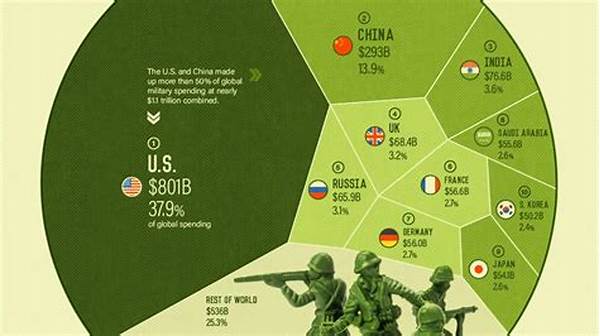The analysis of global defense spending patterns has become imperative for comprehending the geopolitical landscape and its implications on international security. In recent decades, nations have reshaped their defense budgets to address emerging threats and maintain strategic advantages. Understanding these patterns provides insights into the priorities and security concerns of various countries. The intricate dynamics of global defense spending patterns reflect a complex interplay between national interests, technological advancements, and geopolitical tensions. Notably, defense budgets are shaped by a country’s economic capability, perceived threats, and alliances. These expenditures not only reflect a nation’s military capacity but also its commitment to international security and stability. It is crucial to scrutinize these patterns to anticipate future geopolitical shifts and their potential impacts on global peace and security.
Influences on Global Defense Spending
Several factors significantly influence global defense spending patterns. Firstly, regional conflicts and geopolitical tensions prompt countries to augment their defense budgets, ensuring readiness for potential confrontations. Secondly, technological advancements necessitate increased investment in cutting-edge military technologies to maintain a competitive edge. Economic growth also plays a pivotal role; nations experiencing economic prosperity tend to allocate more substantial resources to defense. Additionally, alliances and international commitments compel countries to align their defense expenditures with strategic partners. Lastly, domestic political considerations and public opinion can impact budgetary allocations, reflecting national priorities.
Regional Variations in Defense Spending
Regional disparities in global defense spending patterns are conspicuously marked by varying security concerns and economic capabilities. In Asia, rising tensions in regions such as the South China Sea have catalyzed increased military expenditures. Conversely, European countries often prioritize defense spending in response to perceived threats from neighboring regions. This divergence underscores the influence of regional geopolitics and strategic imperatives on defense budgets globally. Moreover, in the Middle East, ongoing conflicts and sectarian tensions necessitate significant defense investments, reflecting the volatile security terrain. Regional alliances and historical hostilities further accentuate these varied spending priorities. Consequently, analyzing regional defense spending allows for a nuanced understanding of global power dynamics and security strategies.
Technological Impact on Defense Expenditures
The influence of technological advancements on global defense spending patterns cannot be understated. Innovation in warfare technology, such as cyber capabilities and advanced weaponry, compels nations to allocate resources towards modernization efforts. This technological impetus is evident in both developed and developing nations striving to enhance their military capabilities. The acquisition of sophisticated weaponry and cybersecurity measures is crucial in maintaining competitiveness in modern warfare. Consequently, defense budgets increasingly prioritize research and development, underscoring the importance of technological superiority in contemporary military strategy. These investments also influence international arms trade, where technologically advanced nations hold significant leverage.
Economic Constraints and Defense Budgets
Global defense spending patterns are invariably linked to the economic conditions of nations. In economically prosperous countries, defense budgets often witness substantial increases to bolster national security initiatives. Conversely, economic downturns can result in austerity measures impacting defense allocations. Thus, economic stability is a critical determinant of a country’s defense expenditure. Developing nations, grappling with limited resources, often face challenging decisions in balancing defense needs with socio-economic development. Nevertheless, strategic investments in defense are deemed essential for safeguarding national sovereignty and stability, even when economic constraints prevail.
Political Dynamics and Decision-Making
The intricate relationship between political dynamics and global defense spending patterns reflects national priorities and governmental ideologies. Political leadership, electoral considerations, and international alliances contribute to shaping defense budgets. Governments, motivated by the imperative to safeguard national interests, often prioritize military expenditures in response to both domestic and global pressures. Public sentiment and advocacy can further influence these decisions, as democratic processes and civil discourse play vital roles. Consequently, defense policies are often a reflection of comprehensive strategic calculations, encompassing geopolitical considerations and internal political landscapes.
Strategic Outcomes of Global Defense Spending
Global defense spending patterns offer insights into the strategic intentions and military capabilities of nations worldwide. The alignment of defense budgets with perceived threats and alliances underscores a nation’s approach to global security and stability. Additionally, the distribution of military expenditures reflects a nation’s readiness to address contemporary security challenges. By examining these patterns, policymakers and analysts can anticipate potential shifts in the global balance of power and predict emerging geopolitical trends. Ultimately, strategic assessments of defense spending contribute to informed decision-making and foster international collaboration in promoting peace and security.
Summary
In essence, the examination of global defense spending patterns reveals the intricate interplay between geopolitical, economic, technological, and political factors shaping national security strategies. By tracking these expenditures, analysts can deduce a nation’s strategic priorities and its positioning within the international arena. The dynamic nature of global defense spending patterns necessitates continuous monitoring to understand their implications on regional and global stability. Ultimately, these insights are invaluable for policymakers, providing a framework for forging international alliances and collaborations that foster peace, deter aggression, and promote cooperative security measures across diverse geopolitical landscapes.





